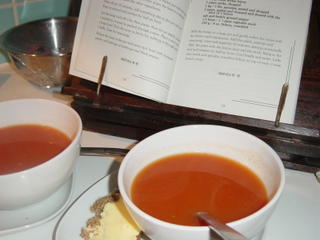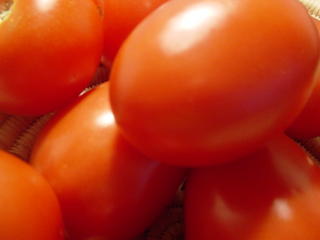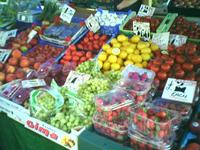Steve’s title: “Spicy pasta soup”
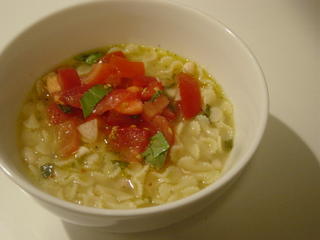
I may have reached some kind of milestone with all of this cooking. Last night, I prepared a soup from the Books for Cooks back catalogue; myself and Blancs were equally disappointed. OK, whilst this may sound like somewhat of an anticlimactic milestone, the fact that we both agreed on what was lacking is an improvement in itself…
Here’s the recipe… check it out, for theory if not for practice:
4 ripe tomatoes, diced
¼ red onion, finely chopped
1 tbsp olive oil
A handful of basil leaves, cut into strips
Salt, black pepper
Soup
4 tbsp olive oil
2 garlic cloves, chopped
½ tsp crushed chilli flakes
125 g cannelloni or haricot beans (soaked overnight and simmered until tender (1 – 1 ½ hours)
90 g small pasta
Salt, black pepper
Grated parmesan to serve
For the salsa, dice the tomatoes (cubes), mix with the onion, olive oil and 1 tbsp of basil leaves. Season as required.

For the soup, heat the oil and add the garlic, chile and remaining basil. You want to release the flavour. To be honest, I didn’t get a big release of flavour, but the instructions recommended 1 minute. I guess just make sure that you don’t brown the garlic so use a low to medium heat.
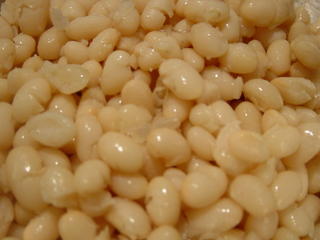
Pour in the stock and beans. Bring to the boil and simmer for 15 minutes. Take out one cupful of beans and liquid and blend until smooth. Add the pasta to the soup and simmer until al dente. I was given a tip recently from Victor a chef at the ElBulli Hotel… bite a single piece of pasta in order to see if it is cooked. The core starch (similar to rice) should have just about vanished.
The recipe recommends serving this as a hot or cold soup. I served it hot.
So, what went wrong? I was eating the soup thinking that there was something missing; texture and flavour. I went along the lines of:
- too much pasta
- too little bean texture
- too bland a flavour; garlic was the predominant flavour
Blancs and I were on the way back from the local this evening and discussed the soup… happily we were both in agreement on the problems. Some solutions recommended:
- use less pasta. It obviously swells up a lot and runs the risk of overwhelming the other somewhat neutral ingredients. I would try maybe 60 g next time.
- use more beans. As the recipe says, this isn’t just a case of not blending the beans… that is needed in order to give body to the soup. I think that you’d need to nearly double the quantity; 200 g?
- regarding the flavour, here was where Blanca revealed some culinary artistry to me… mirepoix.
A chance to research a "classical French cooking technique"... I couldn't resist it. No sooner had I picked up my pen and paper and was approaching the bookshelf, than Blanca suggested that I should blog about some of the books that I reference. I like it... a reference about reference books... circular... a coffee table book that's about coffee table books... you've got to like her style.
I’m still reading my way through the books so couldn’t pretend that I have developed anything but a passing relationship, but here is what I have so far (in order of preference):
1. Harold McGee, “on Food & Cooking“. Any regular reader will know how much I reference McGee... he's gonna chase me for royalties soon. The master of food science, I only respect people with a deep and unfailing love for McGee. He is the only author that manages to cover any topic that I’ve researched.
2. Spaull and Bruce-Gardyne, “Leith’s Techniques Bible”. Great. Blancs is a Cordon Bleu girl so hates the bible (eh, she's Spanish, so not that Bible, the other bible), nevertheless, it’s good for all of the techniques that I don’t understand.
3. Rombauer, Rombauer Becker and Becker, “Joy of Cooking”. Old hat in the US, but still ignored in many parts of Europe. The joy of cooking is the most comprehensive reference and recipe book. It also manages to blend the two very well. My first memory of the Joy of Cooking was seeing it in Blanca's flat in Brussels and getting excited when I thought it was the Joy of Sex... not sure which we would have gotten more use from.
4. Various, “Larousse Gastronomique”. New in (see below) at number 4 and with good potential to move up the charts in the next few weeks.
5. Shirley O. Corriher, “Cookwise” There is something that I don’t like about Cookwise. It falls between the cracks of reference book / recipe book…
6. Stephanie Alexander, “The Cook’s Companion” Not available on amazon.com... I don’t get it (mentally rather than physically). It is really well written, but sorted by ingredient and doesn’t successfully bridge reference and recipes; rarely consulted.
A little bit about Mirepoix
The “Joy of Cooking”, not usually the most poetic of books, evocatively describes the purpose of mirepoix…
“many sauce recipes begin by sautéing a mix of aromatic vegetables… cooking these first in a bit of butter, olive oil, or other fat releases their flavo[u]rs so that as you add other ingredients… the entire sauce becomes infused with the character of the flavour base”… “This universal cooking technique forms the foundation for dishes all across the globe... The French have mirepoix - onions, carrots, and celery cooked gently in butter to bring out their inherent sweetness (a white mirepoix for light-coloured dishes substitutes the white part of leeks for the carrots)”
Well, I can’t really say much more…
Some of the versions are interesting. For example, the Italians sofritto substitutes olive oil for butter (I guess I’m a closet sofritto fan); it can also include fennel, leeks, garlic or chopped herbs such as parsley.
From checking out McGee, it seems to be that celery and fennel are both part of the carrot family. Being stalks rather than roots such as carrot. Leek and onions being both onions (allium). He goes onto say that the Spanish version is called Sofregit.
Until today, the Larousse Gastronomique has only served as a useful stand for my stereo. I must indeed have crossed a significant milestone as Blanca felt it was appropriate to finally include it in my reference material. The LC (as I fondly call it) calls mirepoix a mixture of diced vegetables (carrot, onion and celery). It can be used to enhance the flavour of meat, game and fish, in the preparation of sauces, soups and as a garnish for certain dishes. It is said to have been created in the 18th Century by the chef of the Duc de Levis-Mirepoix in France (ambassador of Louis XV... great grandson to Louis XIV who, according to Dumas, was the brother of the Man in the Iron Mask). OK, too much French for the moment...
The traditional ratio is 2:1:1 onion, celery and carrots. This can of course be varied according to recipe, dish, mathematical ability etc.
----- STOP THE PRESS -----
Blanca has just taken the piss out of McGee and The Joy of Cooking:
- Mirepoix is NOT sofritto. “Mirepoix” can refer to the raw or cooked versions. Sofritto is cooked down vegetables, not just aromatics… it can include, for example, tomatoes
- McGee says that the Spanish version of mierpoix is sofregit… apparently this is Catalan… but I reckon that Blanca is just being anti-nationalist.
I guess that I’m back to square one with my reference book guide… don’t believe anything you read! Or else, Cordon Bleu has put the fear of God into Blanca and she is not willing to discredit the French…

